Thank you for your detailled answer, it was a valuable help for me. In fact, the use of the routing widget produces the correct input string, and you can see the correct syntax.
As a gadget I enclose a user actor that uses the routing input to send an audio signal in a round through 4 speakers. The input value "seconds" determines the duration of the signal on one speaker. For example, n input of 1 second results in a sound loop of 4 seconds , Sounds nice!
Cheers, gunther
You may also find these User Actors helpful, as they essentially rely on the same concept: deadman-x27-s-user-actors.zip
Another staple User Actor, especially for cases like this, is what I call a "Delay Gate"; a User Actor with a Gate that initializes off, then turns on shortly after. I use these all over the place to 'eat' unwanted triggers that generate upon entering a Scene because sometimes they're unavoidable (and sometimes it's just faster for me to throw one of these inline to eat a trigger that I don't want because it's faster than spending the time to examine everything upstream to determine where the trigger is coming from). For example, I use Delay Gates with Comparator actors and Text Comparator actors when I have their 'compare' mode set to 'Always' because you'll always get a true or false trigger out of those actors when you enter a Scene in that mode.
These are not entirely relevant, but here's a couple other groups of simple User Actor 'tools' that I find myself using quite often:
@paz said:
I hope you don't mind me bumping this thread
I don't mind the thread necromancy at all because I always love getting updated gear recommendations.
For the record, @Juriaan was totally right; the way to go if you need POE is to have a decent router (which doesn't need to support POE) for creating the network and then connect that to a decent switch which does support POE. For the most part I've been using POE for PTZ cameras from manufacturers like Birddog and Sony.
Unfortunately I don't have the make and model numbers handy of what I ended up going with, but I've used this configuration in quite a few different venues since I originally posted this thread.
The lowest-tech way to do it is to treat the incoming frames as a "heartbeat". If you connect a Syphon/Spout Receiver actor's output to a Trigger Delay actor, it will continuously reset the timer on the Trigger Delay actor so long as it's receiving new triggers. When the video feed drops out and you aren't receiving any new frames, the Trigger Delay's timer will run out and it will send a trigger that you can use to trigger whatever actions you want to happen if the feed has dropped out.
Here's an example file where I used Isadora to simulate the external video feed and the stand-in content that gets crossfaded to. ----> video-heartbeat-detection-with-auto-crossfade-4.0.9-2025-09-15.izz
Full view of Control Panel and Actors when external feed is live:
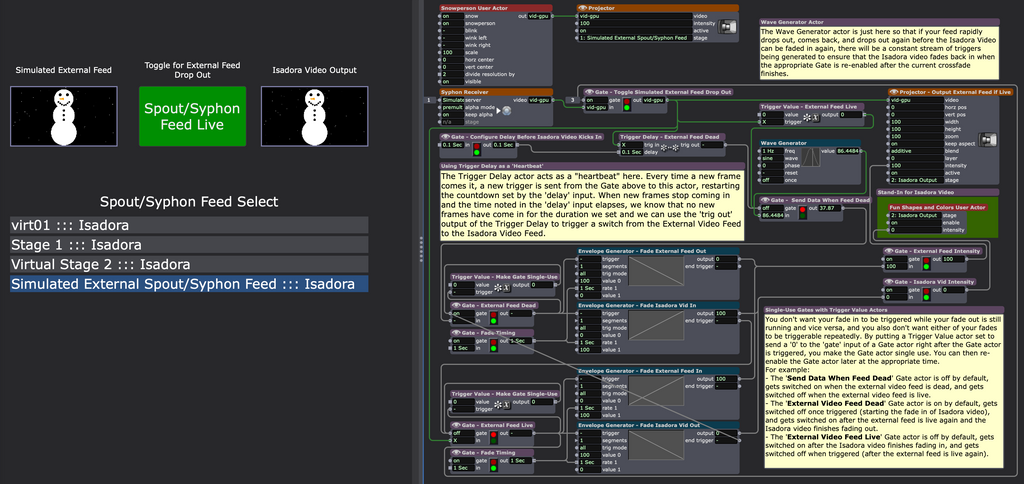
View of Actors when external feed is live:
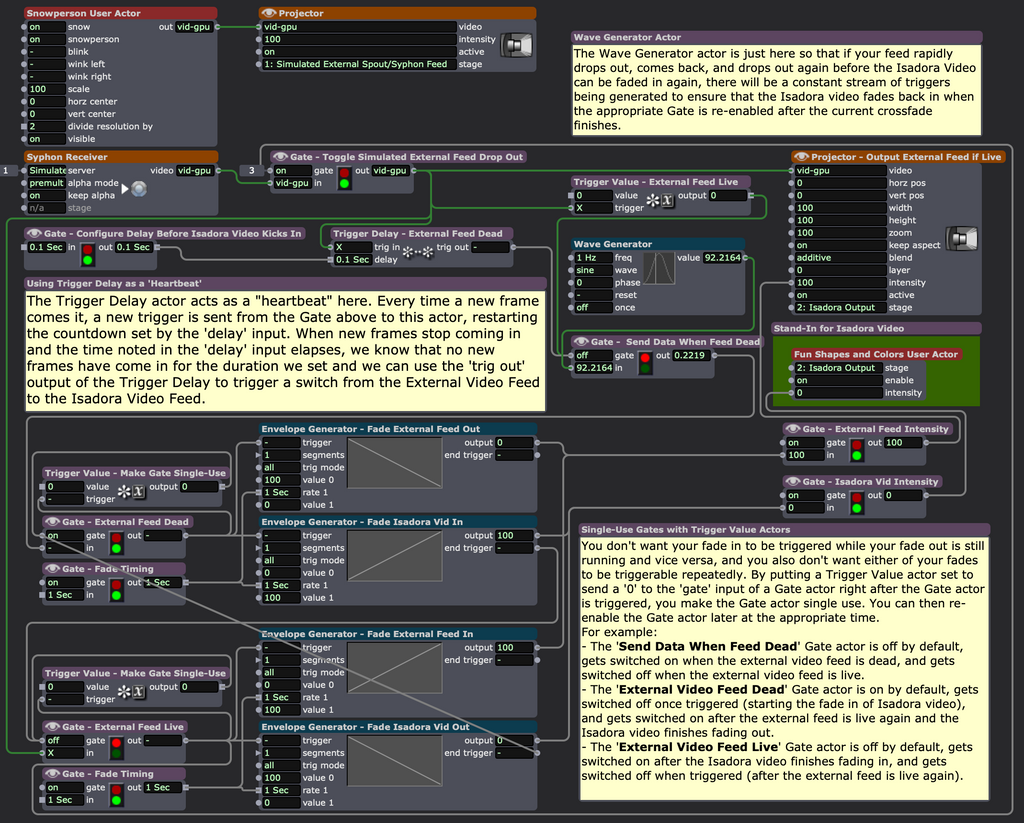
Full view of Control Panel and Actors when external feed is dead:
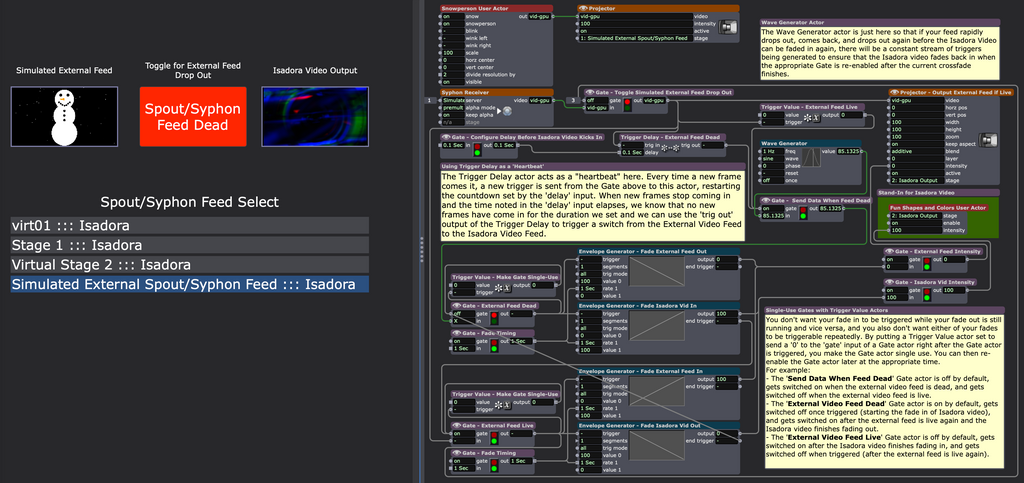
View of Actors when external feed is dead:
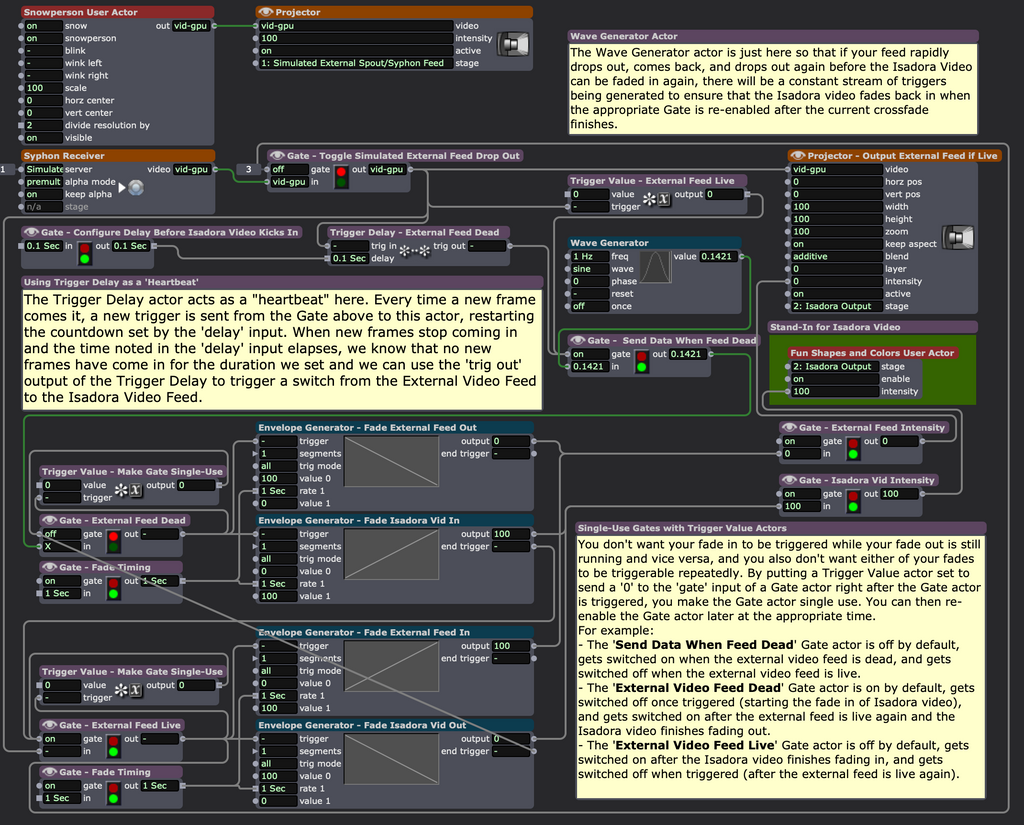
This is a known issue on the two newest versions of macOS that we're already looking into.
For now, if nothing shows up down there even when there's incoming and/or outgoing data, a workaround for the purposes of monitoring communication in a more detailed way is to use the menu options "Windows > Show Status..." and "Windows > Show Monitor..."
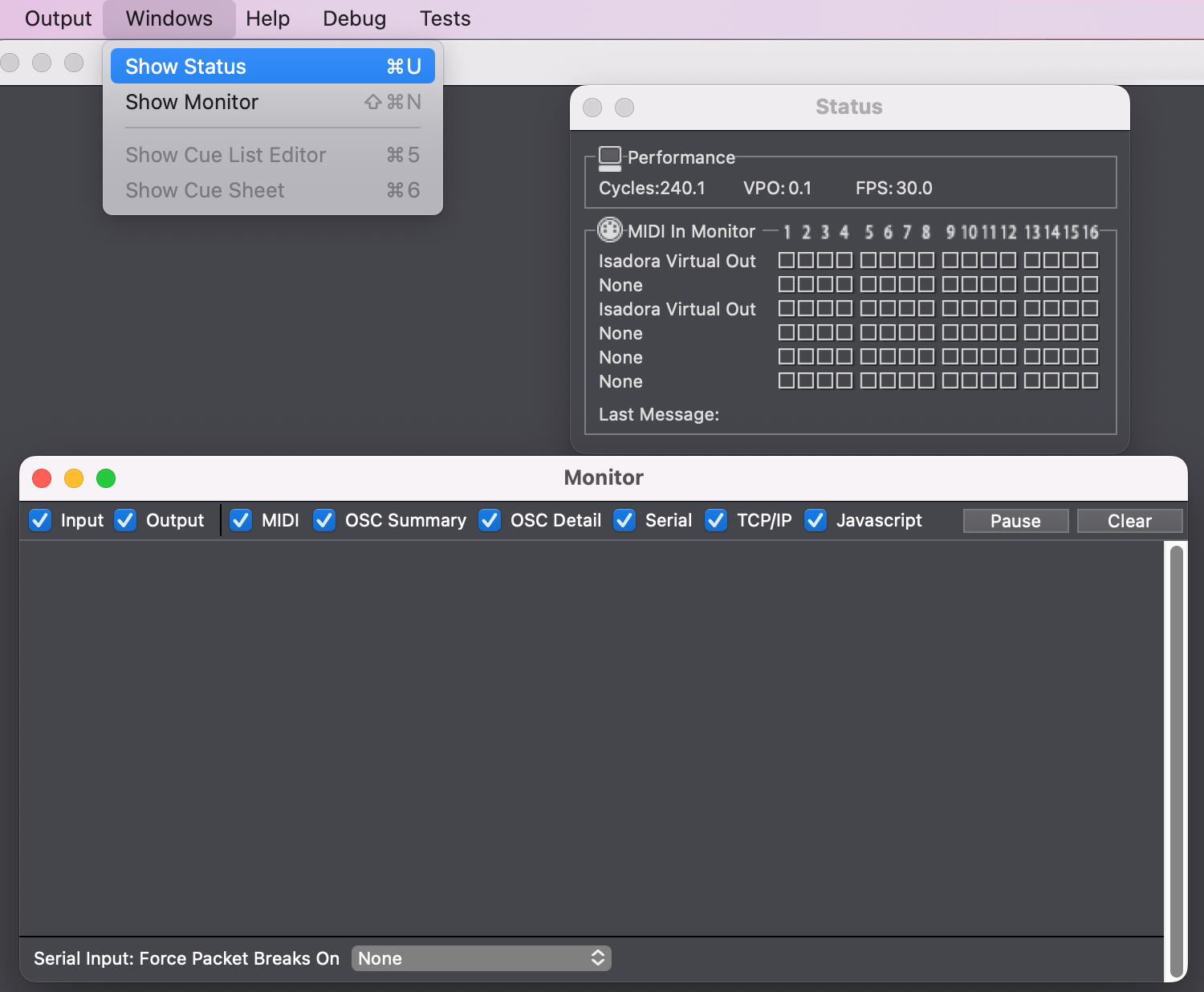
Best wishes,
Woland
@miketutaj
I think that the status indicators are blank when nothing is being sent/received, but become active when signals are happening.
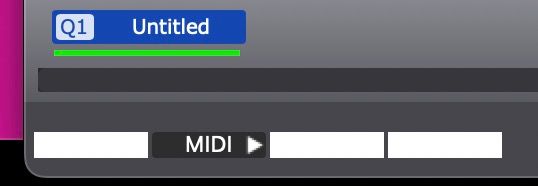
I've encountered an error (on two different computers) where the OSC, MIDI, Serial, and TCP/IP activity indicators in the bottom left corner of the interface window are blanked out, thus hiding the indicators which I find very useful while establishing and troubleshooting connectivity between devices. I've tried reinstalling the software, trashing the preferences, but this still remains the case. It had been occurring since v4.0.9 at least. I've updated to v4.1.3 and the problem remains. See the screenshot that demonstrates the issue.
Current machine is a mac mini M2Pro running MacOS 15.6.1. This also occurs on my MacBook Pro M1Max also running 15.6.1.
Any thoughts on how to remedy this? Many thanks in advance.
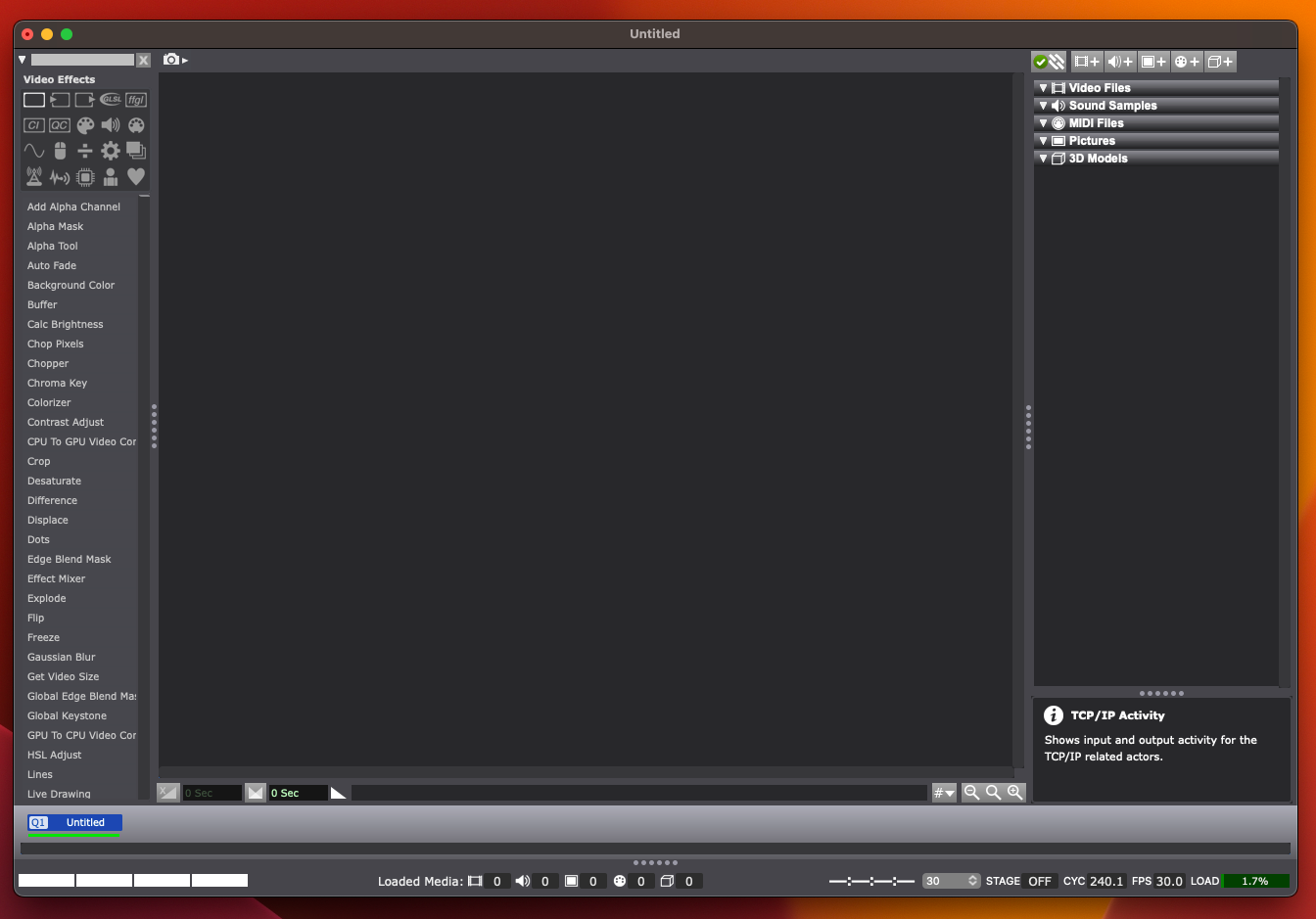
A couple ways I might approach this.
- If possible have Unity send a signal to Isadora (OSC probably). Use this signal to fade in/out your Isadora video.
- Test your Spout stream. What does Isadora 'see' when the stream is stops?
- If the link from the Spout Receiver becomes in active, you can use this to sense when its off by connecting a Tap Tempo actor, it will output the framerate of the incoming video feed when connected. I sometimes connect a Pulse at 2hz to provide a reading when there is no input. Another option that works for feeds that stop (don't read as triggers anymore) is my 'Value Decay' actor, (TROIKATRONIX : ISADORA - DX – Value Decay) if you trigger a value (say 5) into it will every frame it will output a positive value, until the input stops, then it will count down (you can configure this to be pretty fast) until zero, and you can catch that moment using a Comparator actor. In the end there are a number of ways you can create this same 'resetting' of a timer type behaviour.
- If the Spout link doesn't stop triggering, but the video feed just goes black, you can use a Calc Brightness, which will output a brightness >0 when live (as long as its not a black stream) and will output 0 once fully black. So again you can test for this output value with a Comparator.
Ideally, you get a signal from Unity, so you know its status, but both methods of detecting the video state have worked for me in the past.
Hello my fellow Isadorables,
Anyone in the region of Bochum, Germany next Thursday, 18 September, is invited to come and see Natalie Inside Out, the product of my long collaboration with Handstand Maestro Natalie Reckert. We've done it in English, we've done it in French, and now it's the German Language premiere of the show. Lots of fun to be had 'cause Natalie is German.... and I don't speak it at all except for this: Ich bin ein Berliner!
The show's at 2030 at Prinzregent Theatre, Bochum.
Tickets are on sale from 15 September. If you want to come, get in touch. I have a couple of comps. Say hello afterwards! The whole show is powered by Isadora, and we wring just about every drop of blood from her to make this technical and acrobatic spectacular sparkle!
https://www.prt-bochum.de/